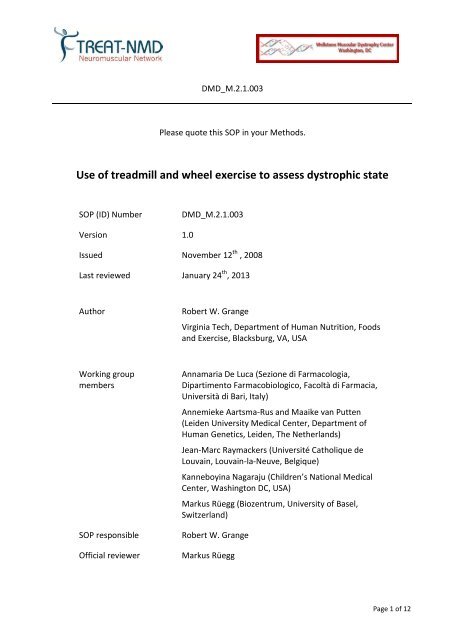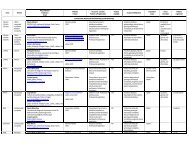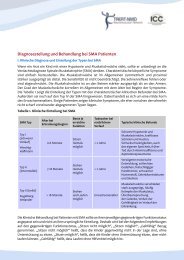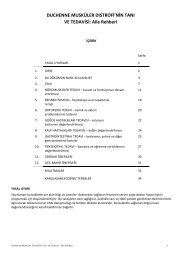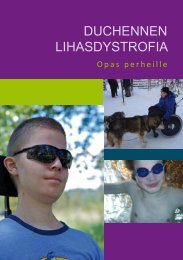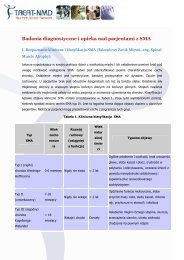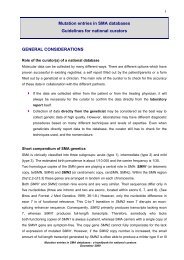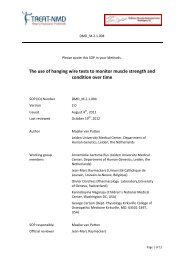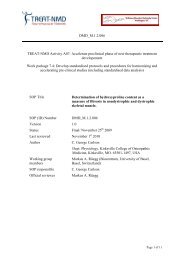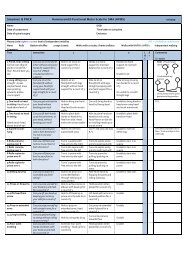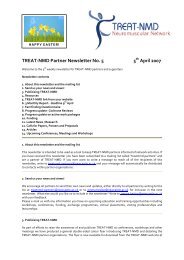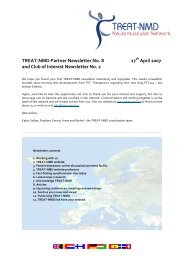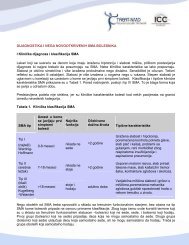Use of treadmill and wheel exercise to assess ... - Treat-NMD
Use of treadmill and wheel exercise to assess ... - Treat-NMD
Use of treadmill and wheel exercise to assess ... - Treat-NMD
Create successful ePaper yourself
Turn your PDF publications into a flip-book with our unique Google optimized e-Paper software.
DMD_M.2.1.003<br />
Please quote this SOP in your Methods.<br />
<strong>Use</strong> <strong>of</strong> <strong>treadmill</strong> <strong>and</strong> <strong>wheel</strong> <strong>exercise</strong> <strong>to</strong> <strong>assess</strong> dystrophic state<br />
SOP (ID) Number<br />
DMD_M.2.1.003<br />
Version 1.0<br />
Issued November 12 th , 2008<br />
Last reviewed January 24 th , 2013<br />
Author<br />
Robert W. Grange<br />
Virginia Tech, Department <strong>of</strong> Human Nutrition, Foods<br />
<strong>and</strong> Exercise, Blacksburg, VA, USA<br />
Working group<br />
members<br />
SOP responsible<br />
Official reviewer<br />
Annamaria De Luca (Sezione di Farmacologia,<br />
Dipartimen<strong>to</strong> Farmacobiologico, Facoltà di Farmacia,<br />
Università di Bari, Italy)<br />
Annemieke Aartsma-Rus <strong>and</strong> Maaike van Putten<br />
(Leiden University Medical Center, Department <strong>of</strong><br />
Human Genetics, Leiden, The Netherl<strong>and</strong>s)<br />
Jean-Marc Raymackers (Université Catholique de<br />
Louvain, Louvain-la-Neuve, Belgique)<br />
Kanneboyina Nagaraju (Children’s National Medical<br />
Center, Washing<strong>to</strong>n DC, USA)<br />
Markus Rüegg (Biozentrum, University <strong>of</strong> Basel,<br />
Switzerl<strong>and</strong>)<br />
Robert W. Grange<br />
Markus Rüegg<br />
Page 1 <strong>of</strong> 12
DMD_M.2.1.003<br />
TABLE OF CONTENTS<br />
1. OBJECTIVE 3<br />
2. SCOPE AND APPLICABILITY 3<br />
3. CAUTIONS 3<br />
3.1. Wheel test 4<br />
3.2. Treadmill 4<br />
4. MATERIALS 5<br />
4.1. Voluntary <strong>wheel</strong> running 5<br />
4.2. Enforced <strong>treadmill</strong> <strong>exercise</strong> 6<br />
5. METHODS 6<br />
5.1. Wheel running 6<br />
5.2. Treadmill <strong>exercise</strong> 8<br />
6. EVALUATION AND INTERPRETATION OF RESULTS 9<br />
7. REFERENCES 11<br />
Page 2 <strong>of</strong> 12
DMD_M.2.1.003<br />
1. OBJECTIVE<br />
The objective <strong>of</strong> this SOP is <strong>to</strong> describe how <strong>treadmill</strong> or <strong>wheel</strong> running <strong>exercise</strong> can be<br />
used <strong>to</strong> evaluate the disease-related impairment <strong>of</strong> neuromuscular function in mdx mice <strong>to</strong><br />
better determine the benefits <strong>of</strong> a specific treatment. The ultimate aim <strong>of</strong> a treatment should<br />
be <strong>to</strong> improve neuromuscular function. Because the dystrophic process affects limb skeletal<br />
muscle, the diaphragm <strong>and</strong> the heart, improvements in these muscles should be ideally<br />
reflected in better physiologic performance. Physiologic performance can be <strong>assess</strong>ed by the<br />
mouse running on a <strong>treadmill</strong> or on a <strong>wheel</strong>. For the <strong>treadmill</strong>, mice are subjected <strong>to</strong> a running<br />
paradigm <strong>to</strong> determine the time <strong>to</strong> exhaustion <strong>and</strong> the <strong>to</strong>tal distance run. For the <strong>wheel</strong><br />
running, mice voluntarily run on a <strong>wheel</strong> in their home cage, <strong>and</strong> the improvement in distance<br />
run per night, per week, per month etc. is <strong>assess</strong>ed. These approaches can be used <strong>to</strong> quantify<br />
the disease-related impairment in either sedentary <strong>and</strong>/or chronically <strong>exercise</strong>d (i.e., <strong>exercise</strong><br />
trained) mdx mice. While the purpose <strong>of</strong> this SOP is <strong>to</strong> describe an approach <strong>to</strong> evaluate the<br />
dystrophic phenotype with or without treatment, <strong>and</strong> in a sedentary or trained state, specific<br />
<strong>exercise</strong> pro<strong>to</strong>cols or experimental conditions can also be used <strong>to</strong> aggravate the dystrophic<br />
process. This approach is described in a separate SOP (DMD_M.2.1.001, <strong>Use</strong> <strong>of</strong> <strong>treadmill</strong> <strong>and</strong><br />
<strong>wheel</strong> <strong>exercise</strong> for impact on mdx mice phenotype).<br />
2. SCOPE AND APPLICABILITY<br />
Running <strong>exercise</strong> on either a <strong>treadmill</strong> or a <strong>wheel</strong> can be used <strong>to</strong> <strong>assess</strong> mdx phenotype<br />
<strong>and</strong>/or <strong>to</strong> evaluate the efficacy <strong>of</strong> therapeutic interventions with pharmacotherapies (Granchelli<br />
et al., 2000; De Luca et al., 2003; Radley <strong>and</strong> Grounds, 2006; Brunelli et al., 2007; Minetti et al.,<br />
2006), gene or cellular strategies (Denti et al., 2006), or nutritional interventions (Call et al.,<br />
2008; Dorchies et al., 2006). Both <strong>treadmill</strong> <strong>and</strong> <strong>wheel</strong> running can be used as early as weaning<br />
age, although mice with spinal muscle atrophy have been trained on a running <strong>wheel</strong> as early as<br />
10 days old (Grondard et al., 2005). As described below, it is m<strong>and</strong>a<strong>to</strong>ry that the <strong>treadmill</strong><br />
controls provide for setting <strong>and</strong> maintaining a specific speed <strong>and</strong> for setting <strong>and</strong> maintaining a<br />
horizontal, downhill or uphill orientation. Downhill running is used <strong>to</strong> generate eccentric<br />
contractions in vivo. However, mdx mice can barely <strong>to</strong>lerate this type <strong>of</strong> running, <strong>and</strong> thus it can<br />
only be used for short-term pro<strong>of</strong>-<strong>of</strong>-concept approaches. However, this may be a valuable<br />
acute test <strong>to</strong> discriminate the efficacy <strong>of</strong> a treatment if the dystrophic mice show only minor<br />
muscle damage similar <strong>to</strong> wild type mice, whereas the untreated dystrophic mice demonstrate<br />
severe muscle damage. All the conditions described below need <strong>to</strong> be followed carefully <strong>to</strong><br />
allow comparison between labora<strong>to</strong>ries. Although less stringent, these recommendations also<br />
apply <strong>to</strong> <strong>wheel</strong> running.<br />
3. CAUTIONS<br />
As is true for any behavioral tests, variables concerning the environment <strong>and</strong> the<br />
animals used must be kept constant throughout the study. These include housing conditions<br />
Page 3 <strong>of</strong> 12
DMD_M.2.1.003<br />
(light, humidity, background noise, etc.), feeding state, schedule <strong>of</strong> the experiments (morning /<br />
afternoon), strain, sex <strong>and</strong> age <strong>of</strong> the mice.<br />
Exercise can modify the progression <strong>of</strong> the disease, therefore it is essential <strong>to</strong> use<br />
st<strong>and</strong>ardized pro<strong>to</strong>cols <strong>and</strong> the proper control mice (e.g., Call et al., 2008; Carter et al., 1995).<br />
3.1 Wheel test<br />
Advantages<br />
The <strong>wheel</strong> test reveals each individual animal’s voluntary capacity for running. There is<br />
no need for further acclimatization after the first session <strong>and</strong> minimal human intervention is<br />
required while the mice run. This <strong>exercise</strong> can be initiated during early maturation (usually at<br />
or after weaning) <strong>and</strong> continued for set periods <strong>of</strong> time (e.g., one <strong>to</strong> several weeks) or<br />
indefinitely throughout the mouse’s life, according <strong>to</strong> the experimental purposes. Noninvasive<br />
in vivo testing <strong>of</strong>fers the great advantage that it can be readministered, so that each animal can<br />
become its own control (provided that the mice are examined during a steady-state phase <strong>of</strong><br />
neuromuscular development, i.e. 4-6 months <strong>of</strong> age). Obviously, this implies making the same<br />
examinations in untreated animals, <strong>to</strong> differentiate the effects <strong>of</strong> <strong>exercise</strong> from those due <strong>to</strong> the<br />
treatment.<br />
Disadvantages<br />
There can be wide variation in the amount <strong>of</strong> running between individual mice, requiring<br />
a large number <strong>of</strong> animals <strong>to</strong> reach statistical significance. To determine the number <strong>of</strong> animals<br />
required, a Power analysis should be performed. There are also differences between male <strong>and</strong><br />
female runners; females run further each night. Other disadvantages, which mainly relate <strong>to</strong> the<br />
use <strong>of</strong> <strong>wheel</strong> running for chronic <strong>exercise</strong>, are that the mice are caged individually, with a<br />
possible impact on their behavior, <strong>and</strong> that a change in <strong>wheel</strong> properties as a result <strong>of</strong> dirt<br />
accumulation can potentially increase the effort required by the animal <strong>to</strong> perform the running<br />
test. Differences in the design <strong>of</strong> particular <strong>wheel</strong>s may also account for the different results<br />
obtained by different labora<strong>to</strong>ries: Indeed, some designs allow the <strong>wheel</strong> resistance <strong>to</strong> be set <strong>to</strong><br />
increase the workload. Although generally affordable, a complete setup can also be somewhat<br />
expensive.<br />
3.2 Treadmill<br />
Advantages<br />
Exercise parameters such as speed, duration <strong>and</strong> angle <strong>of</strong> the <strong>treadmill</strong> can be strictly<br />
controlled <strong>to</strong> fulfill a variety <strong>of</strong> experimental pro<strong>to</strong>cols <strong>and</strong> allow a precise <strong>exercise</strong> load <strong>to</strong> be<br />
set. All <strong>of</strong> the mice belonging <strong>to</strong> an experimental group undergo the same pro<strong>to</strong>col <strong>and</strong> this<br />
allows precise moni<strong>to</strong>ring <strong>of</strong> the neuromuscular performance <strong>of</strong> each mouse in <strong>and</strong> between<br />
Page 4 <strong>of</strong> 12
DMD_M.2.1.003<br />
experimental groups. Control <strong>of</strong> the parameters facilitates comparison <strong>of</strong> results from different<br />
labora<strong>to</strong>ries. Ideally, if the environmental <strong>and</strong> <strong>exercise</strong> conditions are the same, this will limit<br />
bias.<br />
Disadvantages<br />
Unlike <strong>wheel</strong> running, <strong>treadmill</strong> experiments cannot be conducted without an<br />
acclimatizing period <strong>of</strong> 3 <strong>to</strong> 10 days, during which animals become familiar with the apparatus<br />
<strong>and</strong> can then train for longer periods <strong>of</strong> time <strong>and</strong> at higher speeds. Running can induce a certain<br />
level <strong>of</strong> stress in the animal. Continuous supervision by one or more experimenters is required.<br />
Although anecdotal evidence indicates that the concomitant running <strong>of</strong> 5-6 mice ensures better<br />
adherence (emulation phenomenon?), experimenters may choose <strong>to</strong> reduce the number <strong>of</strong><br />
mice being tested at the same time <strong>to</strong> more closely observe each individual mouse. As a<br />
consequence, the time required <strong>to</strong> conduct the test will be substantial. Finally, <strong>treadmill</strong>s are<br />
expensive. As described above, there is great variability in the performances achieved by<br />
different animals, even from the same litter. The response <strong>to</strong> a given drug itself is certainly<br />
different from one mouse <strong>to</strong> another. There are three possibilities for dealing with this<br />
variability: (1) moni<strong>to</strong>r each mouse individually, before, during <strong>and</strong> after treatment, <strong>and</strong> express<br />
the efficacy <strong>of</strong> a drug as the post/pre ratio (“mean <strong>of</strong> the differences”, rather than “differences<br />
in the means”); (2) adapt the experimental condition <strong>to</strong> their initial performances; this implies<br />
determining for example, the maximal speed at which the animal can run, <strong>and</strong> measuring time<br />
<strong>to</strong> exhaustion at 80% <strong>of</strong> the maximal speed; <strong>and</strong> (3) use only mice that demonstrate a<br />
comparable performance, as determined by a preliminary test. Optimally, the 3 possibilities can<br />
be used <strong>to</strong>gether. This approach will increase the experiment time, but should lower the<br />
variability so that an effect has a greater chance <strong>to</strong> be observed.<br />
4. MATERIALS<br />
4.1 Voluntary <strong>wheel</strong> running<br />
A metal mouse <strong>wheel</strong> can be placed on the cage floor, suspended from the cage <strong>to</strong>p or<br />
attached <strong>to</strong> the cage side. Exercise data can be obtained from the <strong>wheel</strong> via self-built detection<br />
systems or by au<strong>to</strong>mated commercial systems. Two examples <strong>of</strong> self-built systems are the<br />
following; (1) a small magnet can be attached <strong>to</strong> the <strong>wheel</strong> <strong>and</strong> a sensor from a bicycle<br />
pedometer attached <strong>to</strong> the back <strong>of</strong> the cage (Radley <strong>and</strong> Grounds, 2006); (2) a metal tab<br />
attached <strong>to</strong> the rear <strong>of</strong> the <strong>wheel</strong> can be used <strong>to</strong> interrupt a light signal <strong>to</strong> a pho<strong>to</strong> electric gate.<br />
Each signal interrupt can be recorded on a lap<strong>to</strong>p computer using a digital data acquisition card<br />
(National Instruments USB-6501, Part # 779205-01) <strong>and</strong> a cus<strong>to</strong>m Labview program (Call et al.<br />
2008). In both cases, the sensor records single <strong>wheel</strong> revolutions. Daily <strong>and</strong> <strong>to</strong>tal distance (km),<br />
as well as maximal <strong>and</strong> average speed can be recorded each day (e.g., Radley <strong>and</strong> Grounds,<br />
2006). A more sophisticated computerized moni<strong>to</strong>ring system can be used <strong>to</strong> collect precise<br />
data on the patterns <strong>of</strong> running <strong>and</strong> s<strong>to</strong>pping (e.g., Lafayette Instruments, Inc.; MiniMitter with<br />
Vital View s<strong>of</strong>tware, Minimitter Inc.).<br />
Page 5 <strong>of</strong> 12
DMD_M.2.1.003<br />
4.2 Enforced <strong>treadmill</strong> <strong>exercise</strong><br />
A variety <strong>of</strong> <strong>treadmill</strong>s are commercially available <strong>and</strong> allow the mouse <strong>to</strong> perform<br />
horizontal, uphill, or downhill running at a fixed speed. Each lane <strong>of</strong> the <strong>treadmill</strong> is physically<br />
separated on the same belt, so that up <strong>to</strong> six mice can be <strong>exercise</strong>d simultaneously at the same<br />
speed <strong>and</strong> angle. Some <strong>treadmill</strong>s have computerized systems <strong>to</strong> record <strong>exercise</strong> time, <strong>and</strong> a<br />
grid for delivering a low-intensity electric shock <strong>to</strong> the mouse’s paws when the mouse s<strong>to</strong>ps.<br />
Other <strong>treadmill</strong>s are built in a closed environment that allows the collection <strong>of</strong> respira<strong>to</strong>ry gases<br />
for detailed analysis <strong>of</strong> gas exchange. One <strong>of</strong> the most widely used <strong>treadmill</strong> models is from<br />
Columbus Instruments (illustrated below).<br />
5. METHODS<br />
5.1 Wheel running<br />
Individually caged mice are allowed <strong>to</strong> freely move on the <strong>wheel</strong> for <strong>exercise</strong>. According<br />
<strong>to</strong> the circadian rhythm <strong>of</strong> rodents, mice generally run at night. The detection system records<br />
<strong>and</strong> saves the active running time for each mouse in each cage. Every day the experimenter can<br />
obtain data <strong>of</strong> the <strong>to</strong>tal distance run, the time <strong>of</strong> major activity <strong>and</strong>/or <strong>of</strong> rest, <strong>and</strong> the intervals<br />
<strong>of</strong> active time, such as shortest <strong>and</strong> longest lag interval time. Single animal data can be then<br />
compared with those <strong>of</strong> other animals <strong>and</strong> eventually pooled if responses are uniform. (Hara et<br />
al., 2002; Radley <strong>and</strong> Grounds; 2006; Brunelli et al., 2007). Note that accumulation <strong>of</strong> dust <strong>and</strong><br />
other materials may increase rotational resistance <strong>of</strong> the <strong>wheel</strong>. Free movement <strong>of</strong> the <strong>wheel</strong><br />
<strong>and</strong> the correct recording <strong>of</strong> revolutions should be regularly checked <strong>and</strong> corrected as<br />
necessary. In addition, the experimenter should also be aware that mice may turn the <strong>wheel</strong><br />
during normal movement in the cage without actually running in it.<br />
Frequency, intensity <strong>and</strong> duration <strong>of</strong> <strong>wheel</strong> running. Frequency is the number <strong>of</strong> times<br />
the animals are allowed <strong>to</strong> run per week. This could be set for an experiment from 1 <strong>to</strong> 7 days<br />
per week. For non-computerized <strong>wheel</strong> systems, the <strong>wheel</strong> would have <strong>to</strong> be locked by the<br />
experimenter <strong>to</strong> prevent running on non-<strong>exercise</strong> days. This could be done by using a wire hook<br />
from the <strong>wheel</strong> <strong>to</strong> the wire cage <strong>to</strong>p for example. Intensity is the load against which the mouse<br />
works on the <strong>wheel</strong>. In most cases, the mice will only run against the resistance <strong>of</strong> the <strong>wheel</strong><br />
Page 6 <strong>of</strong> 12
DMD_M.2.1.003<br />
itself. However, some computerized systems (e.g., Lafayette Instruments, Inc.) have an<br />
electronic brake on the <strong>wheel</strong> that can increase the resistance through computer control.<br />
Duration is the time the mouse is allowed <strong>to</strong> run on the <strong>wheel</strong> for any given <strong>exercise</strong><br />
session. Normally the mice would be allowed <strong>to</strong> run all night, but duration <strong>of</strong> 1 or more hours<br />
could also be used. Ideally, with a computerized system, the brake could be programmed <strong>to</strong><br />
come on after a certain duration. However, if duration is <strong>to</strong> be manipulated with a manual<br />
running system, an experimenter would have <strong>to</strong> be present <strong>to</strong> limit the duration by manually<br />
locking the <strong>wheel</strong>.<br />
Matched workloads. Exercise induces both positive <strong>and</strong> negative adaptations. To avoid<br />
differences between treatment groups due <strong>to</strong> the amount <strong>of</strong> <strong>exercise</strong> performed, the dose <strong>of</strong><br />
<strong>exercise</strong> should be matched. For example, <strong>exercise</strong> doses for wt <strong>and</strong> mdx runners could be<br />
matched as follows: (1) mice from two different treatment groups are r<strong>and</strong>omly paired (e.g.,<br />
mdx <strong>and</strong> wt mice). Mdx running dose (i.e., distance per night) for each pair will be recorded,<br />
then this data will be used <strong>to</strong> ensure a match <strong>of</strong> the distance run per night by the paired wt<br />
runner. Running by wt <strong>and</strong> mdx mice will be initially staggered by one night. Mdx but not wt<br />
mice <strong>of</strong> each pair will run the first night, <strong>to</strong> record the running dose. On the 2 nd night through<br />
the end <strong>of</strong> the training period, both mdx <strong>and</strong> wt mice <strong>of</strong> each pair will run, with wt mice<br />
restricted <strong>to</strong> the dose <strong>of</strong> running performed by the mdx mice the previous night. Wt mice will<br />
complete the training period one day later than mdx mice. Ideally, computer controlled running<br />
<strong>wheel</strong>s for each wt mouse would s<strong>to</strong>p the <strong>wheel</strong> au<strong>to</strong>matically when the appropriate distance<br />
from the respective mdx mouse for each pair is reached. If a computerized system is not<br />
available, this would have <strong>to</strong> be done manually.<br />
Example Study: Two groups <strong>of</strong> mdx mice (n=10 per group), one control <strong>and</strong> one treated<br />
are compared for distance run per night, week, month, etc. for a given training period at a given<br />
frequency, intensity <strong>and</strong> duration.<br />
Frequency = 7 times per week<br />
Intensity = <strong>wheel</strong> resistance only<br />
Duration = self selected<br />
Training period = 3, 6, 12 weeks (e.g., Call et al., 2008; Hayes et al, 1996).<br />
Additional groups <strong>of</strong> sedentary mdx mice without <strong>and</strong> with treatment could also be included in<br />
the study. This would help <strong>to</strong> distinguish between the effects <strong>of</strong> the treatment alone <strong>and</strong> the<br />
treatment plus <strong>exercise</strong>.<br />
Another approach would be <strong>to</strong> have two groups <strong>of</strong> sedentary mdx mice, one treated<br />
with a given drug <strong>and</strong> one that is not. After a set treatment period (e.g., 6 weeks), both groups<br />
<strong>of</strong> mice are <strong>assess</strong>ed for their capacity <strong>to</strong> run on the <strong>wheel</strong> over some set period (e.g., 3 weeks).<br />
More sophisticated analyses could also be conducted while the mice run on <strong>wheel</strong>s in an<br />
enclosed chamber so gas exchange can be evaluated (e.g., TSE Systems Inc.,<br />
LabMaster/Calorimetry system; Columbus Instruments, Inc. Oxymax/CLAMS system).<br />
Page 7 <strong>of</strong> 12
DMD_M.2.1.003<br />
Voluntary <strong>wheel</strong> running distances by C57BL/10 <strong>and</strong> mdx mice. Maximum values<br />
during the training period are reported below.<br />
Carter et al.,1995: 4 weeks training; young mdx mice (gender not reported) aged 4-8 weeks -<br />
~6000 m/night; young C57BL/10 mice - ~9000 m/night; old mdx mice aged 6-7months - ~3000<br />
m/night; old C57BL/10 mice aged 6-7 months - ~9500 m/night.<br />
Hayes <strong>and</strong> Williams, 1996: young male mdx mice aged 4-20 weeks - ~5400 m/night; young<br />
C57BL/10 - ~8500 m/night.<br />
Call et al., 2008: 3 weeks training; male mdx mice aged 3-6 weeks - ~2000 m/night; male<br />
C57BL/10 mice aged 3-6 weeks - ~6000 m/night.<br />
Treadmill <strong>exercise</strong><br />
One mouse is placed in each lane <strong>and</strong> is enforced <strong>to</strong> run at a certain speed with the<br />
<strong>treadmill</strong> orientation held at 0°. The mice are run <strong>to</strong> exhaustion <strong>and</strong> the time <strong>of</strong> running is<br />
recorded.<br />
Chronic <strong>exercise</strong>. When <strong>treadmill</strong> running is used for chronic <strong>exercise</strong>, a fixed pro<strong>to</strong>col<br />
should be used, according <strong>to</strong> pro<strong>to</strong>cols <strong>and</strong> procedures described in detail in the SOP<br />
M.2.1_001, <strong>Use</strong> <strong>of</strong> <strong>treadmill</strong> <strong>and</strong> <strong>wheel</strong> <strong>exercise</strong> for impact on mdx mice phenotype. (Granchelli<br />
et al., 2000; De Luca et al., 2003, 2005).<br />
In this SOP, the <strong>exercise</strong> pro<strong>to</strong>cols described are used <strong>to</strong> <strong>assess</strong> the impact <strong>of</strong> treatment<br />
on neuromuscular function. For example, the effectiveness <strong>of</strong> a drug treatment could be<br />
evaluated by <strong>assess</strong>ing how far the mouse can run before exhaustion. Other parameters (in vivo<br />
<strong>and</strong> mostly ex vivo) can then be used <strong>to</strong> evaluate the disease state. Again, these approaches are<br />
described in other SOPs. However, information (e.g., the number <strong>of</strong> s<strong>to</strong>ps/mouse; the duration<br />
<strong>of</strong> the s<strong>to</strong>p) obtained during each <strong>exercise</strong> session are also useful in <strong>assess</strong>ing the disease<br />
severity. For example, mice with a more severe disease state s<strong>to</strong>p more frequently than less<br />
severely diseased mice. To obtain this “s<strong>to</strong>p” information, the number <strong>of</strong> s<strong>to</strong>ps <strong>and</strong> the duration<br />
(e.g., a s<strong>to</strong>pwatch) <strong>of</strong> each would have <strong>to</strong> be recorded. However, <strong>to</strong> obtain this detailed<br />
information, a second experimenter would be necessary or fewer mice would have <strong>to</strong> be run if<br />
there is only one experimenter. Consistency <strong>of</strong> this latter measurement is more difficult <strong>to</strong><br />
obtain vs. overall running resistance <strong>and</strong> therefore less used as readout parameter.<br />
Example <strong>exercise</strong> training (for evaluation <strong>of</strong> number <strong>of</strong> s<strong>to</strong>ps during a fixed <strong>exercise</strong><br />
duration): Exercise compared <strong>to</strong> a sedentary group <strong>of</strong> mdx mice with <strong>and</strong> without treatment:<br />
(1) 12 m/min for 30 min twice a week for some specified period (e.g., 3, 6 <strong>and</strong> 8 weeks;<br />
Granchelli et al., 2000; De Luca et al., 2003, 2005). (2) 9m/min for 30 min, twice a week for<br />
some specified period (e.g., 3, 6 <strong>and</strong> 8 weeks; Kaczor et al., 2007; Hudecki et al., 1993).<br />
Example run <strong>to</strong> exhaustion: The speed is initially set at 5 m/min for 5 min, <strong>and</strong> then the<br />
speed is increased 1 m/min every minute until exhaustion. A specific criterion for exhaustion<br />
should be pre-determined. For example, the mouse will not continue running on the <strong>treadmill</strong><br />
for 20 s despite repeated gentle nudges <strong>to</strong> make it do so (e.g., Brunelli et al., 2007; Denti et al.,<br />
2006).<br />
Page 8 <strong>of</strong> 12
DMD_M.2.1.003<br />
For this exhaustion test, typical distance values for sedentary wild-type male mice<br />
(C57/BL10) aged 8-12 weeks are approximately 250-300 meters. Values for sedentary mdx mice<br />
<strong>of</strong> the same age are lower (~180-200 m) with distances even less when the pathology is worse<br />
or subsequent <strong>to</strong> chronic forced <strong>exercise</strong> pro<strong>to</strong>cols (70-100 m).<br />
Treadmill Maintenance. Most commercial <strong>treadmill</strong>s are designed <strong>to</strong> collect wastes;<br />
however this is not sufficient for the belt. This has <strong>to</strong> be properly <strong>and</strong> gently cleaned after each<br />
<strong>exercise</strong> session <strong>to</strong> avoid dust <strong>and</strong> organic waste from reducing adherence <strong>of</strong> the mouse paws,<br />
as well as change the speed belt efficiently. Periodically, the speed <strong>of</strong> the belt has <strong>to</strong> be verified<br />
by measuring the time required by a small fixed object on the belt <strong>to</strong> cover the distance<br />
between two points (beginning <strong>and</strong> end <strong>of</strong> the lane at a known distance) <strong>and</strong> verifying that it<br />
corresponds with the speed value chosen by the experimenter.<br />
6. EVALUATION AND INTERPRETATION OF RESULTS<br />
When <strong>exercise</strong> is used <strong>to</strong> evaluate the progression <strong>of</strong> the dystrophic pathology <strong>and</strong> or<br />
the effect <strong>of</strong> a therapy the objective data obtained are used <strong>to</strong> determine,<br />
1) the <strong>to</strong>tal distance run by each mouse until exhaustion (<strong>treadmill</strong>)<br />
2) the change in the <strong>to</strong>tal distance run by each mouse until exhaustion over time<br />
(longitudinal studies for chronic treatment)<br />
3) the <strong>to</strong>tal distance run by each mouse in acute tests <strong>and</strong> over time (<strong>wheel</strong> <strong>exercise</strong>) <strong>and</strong><br />
relative speed<br />
4) the duration <strong>of</strong> each bout <strong>of</strong> voluntary running session (<strong>wheel</strong> <strong>exercise</strong>)<br />
5) change in pattern <strong>of</strong> running over time (duration <strong>and</strong> number <strong>of</strong> shortest <strong>and</strong> longest<br />
running session) (<strong>wheel</strong> <strong>exercise</strong>)<br />
Importantly, the collection <strong>of</strong> the data should include additional information:<br />
a) that all the mice performed the required <strong>exercise</strong> correctly (<strong>treadmill</strong>)<br />
b) the <strong>to</strong>tal amount/pattern <strong>of</strong> <strong>exercise</strong> performed by each mouse<br />
c) inter-animal variability<br />
d) possible correlations with between therapy <strong>and</strong> pathology course<br />
All observational data are extremely important <strong>to</strong> underst<strong>and</strong> the consistency <strong>of</strong> the<br />
pro<strong>to</strong>col <strong>and</strong> <strong>to</strong> account for concomitant disturbing events, such as stress. These observations<br />
include:<br />
<br />
<br />
<br />
Body weight (<strong>to</strong> be moni<strong>to</strong>red weekly)<br />
Food <strong>and</strong> water consumption (moni<strong>to</strong>red weekly)<br />
Change in mood (<strong>to</strong>o nervous or <strong>to</strong>o sleepy (moni<strong>to</strong>red daily))<br />
Page 9 <strong>of</strong> 12
DMD_M.2.1.003<br />
<br />
<br />
<br />
Marked change in the ability <strong>to</strong> perform the <strong>exercise</strong> (i.e., more than 3 s<strong>to</strong>ps per each<br />
<strong>treadmill</strong> trial session; no <strong>wheel</strong> <strong>exercise</strong>)<br />
Change in fore limb strength (as <strong>assess</strong>ed by grip strength)<br />
Change in social habits (for <strong>treadmill</strong>)<br />
All these data should be consistently recorded in a lab book <strong>to</strong> provide immediate or<br />
subsequent analysis.<br />
Page 10 <strong>of</strong> 12
DMD_M.2.1.003<br />
7. REFERENCES<br />
Bouchen<strong>to</strong>uf M, Benabdallah BF, Mills P, Tremblay JP. (2006). Exercise improves the success <strong>of</strong><br />
myoblast transplantation in mdx mice. Neuromuscul Disord. 8:518-29.<br />
Brunelli S, Sciorati C, D'An<strong>to</strong>na G, Innocenzi A, Covarello D, Galvez BG, Perrotta C, Monopoli A,<br />
Sanvi<strong>to</strong> F, Bottinelli R, Ongini E, Cossu G, Clementi E. (2007). Nitric oxide release combined with<br />
nonsteroidal antiinflamma<strong>to</strong>ry activity prevents muscular dystrophy pathology <strong>and</strong> enhances<br />
stem cell therapy. Proc. Natl. Acad. Sci. USA. 104:264-269.<br />
Call, JA, Voelker KA, Wolff AV, Macmillan RP, Evans NP, Hulver MW, Talmadge RJ Grange RW.<br />
(2008). Endurance capacity in maturing mdx mice is markedly enhanced by combined voluntary<br />
<strong>wheel</strong> running <strong>and</strong> green tea extract. J Appl Physiol. [Epub ahead <strong>of</strong> print; doi:101152]<br />
Carter GT, Wineinger MA, Walsh SA, Horasek SJ, Abresch RT, Fowler WM Jr. (1995). Effect <strong>of</strong><br />
voluntary <strong>wheel</strong>-running <strong>exercise</strong> on muscles <strong>of</strong> the mdx mouse. Neuromuscul Disord 5:323–<br />
332.<br />
De Luca A, Pierno S, Lian<strong>to</strong>nio A, et al. (2003). Enhanced dystrophic progression in mdx mice by<br />
<strong>exercise</strong> <strong>and</strong> beneficial effects <strong>of</strong> taurine <strong>and</strong> insulin-like growth fac<strong>to</strong>r-1. J. Pharmacol. Exper.<br />
Ther. 304:453-463.<br />
De Luca A, Nico B, Lian<strong>to</strong>nio A, et al. (2005). A multidisciplinary evaluation <strong>of</strong> the effectiveness<br />
<strong>of</strong> cyclosporine a in dystrophic mdx mice. Am. J. Pathol. 166:477-489.<br />
Denti MA, Rosa A, D'An<strong>to</strong>na G, Sth<strong>and</strong>ier O, De Angelis FG, Nicoletti C, Allocca M, Pansarasa O,<br />
Parente V, Musarò A, Auricchio A, Bottinelli R, Bozzoni I. (2006). Body-wide gene therapy <strong>of</strong><br />
Duchenne muscular dystrophy in the mdx mouse model. Proc. Natl. Acad. Sci. USA. 103:3758-<br />
3763.<br />
Dorchies OM, WagnerS, VuadensO, WaldhauserK, BuetlerTM, KuceraP, RueggUT. (2006). Green<br />
tea extract <strong>and</strong> its major polyphenol(-)- epigallocatechingallate improve muscle function in a<br />
mouse model for Duchenne muscular dystrophy. Am J Physiol Cell Physiol 290:C616–C625.<br />
Grondard C, Biondi O, Arm<strong>and</strong>, AS, Lecolle S, Della Gaspera B, Pariset C, Li H, Gallien CL, Vidal<br />
PP, Chanoine C, Charbonnier F. (2005). Regular <strong>exercise</strong> prolongs survival in a type 2 spinal<br />
muscular atrophy model mouse. J Neurosci. 25(33):7615-22.<br />
Granchelli JA, Pollina C <strong>and</strong> Hudecki MS. (2000). Pre-clinical screening <strong>of</strong> drugs using the mdx<br />
mouse. Neuromuscul Disord. 10(4-5):235-9.<br />
Page 11 <strong>of</strong> 12
DMD_M.2.1.003<br />
Hara H, Nolan PM, Scott MO, Bucan M, Wakayama Y, Fischbeck KH. (2002). Running endurance<br />
abnormality in mdx mice. Muscle Nerve 25:207-211.<br />
Hayes A, <strong>and</strong> Williams DA. (1996). Beneficial effects <strong>of</strong> voluntary <strong>wheel</strong> running on the<br />
properties <strong>of</strong> dystrophic mouse muscle. J Appl Physiol 80: 670-679.<br />
Hayes A, Williams DA. (1998). Contractile function <strong>and</strong> low-intensity <strong>exercise</strong> effects <strong>of</strong> old<br />
dystrophic (mdx) mice. Am. J. Physiol.274 (4 Pt 1):C1138-44.<br />
Page 12 <strong>of</strong> 12


